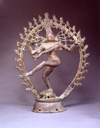|
Shiva as Lord of the Dance (Shiva Nataraja)
|
||
 India, Tamil Nadu
India, Tamil NaduChola period (880-1279), about 970 Copper alloy H. 26 3/4 in. (67.9 cm); 1979.20 |
||
|
|
||
|
Chandralekha In the fantasy of the ninth and tenth century bronze-casters, every Apasmara assumed a different gestural form and sculptural weight. They were able to build in an exquisite tension between the upturned, agitated, agonized figure pinned to the ground by Nataraja's balancing foot, fixed in a slippery, stubborn mood of escape, and Nataraja's expression of bliss (ananda) at fulfilling the purpose of his dance-to contain the dehumanized forces through the energy and awakening of dance, and restore balance to the universe. The idea of
integrating this crouching, distorted, prone figure of the dwarf-demon
in my choreography was, in itself, an unconven- tional and contemporary
direction for me as it necessitated opening out an area neglected
in our classical dance, the floor level. It also enabled a direct
addressing of contemporary issues of false consciousness. Most importantly,
it enabled me to present the icon in its totality and draw attention
to Shiva Nataraja's precarious balancing act which infuses dynamic
tension to his form, while celebrating the sheer joy of combating
negative energy.
Gita Mehta This is Shiva as the Destroyer and Shiva as the Destroyer of Destruction: as two forms of time - kala, temporary time, and mahakala, eternal time. In one hand he holds a drum-symbol of the sound of Om and of the vibration which is the origin of creation. In another he holds a flame to incinerate the cosmos and permit creation of the next. A hand points to a foot dancing on a dwarf, symbolic of the evil which yokes men to the wheel of existence through heedlessness, inattention, oblivion. The raised foot offers release, through awareness, from endured time, kala, the endless cycle of rebirth. A raised hand indicates the sublime consciousness that results from union with mahakala, eternal time. Containing the most complex philosophical perceptions in a single simple image the Nataraja is, for me, the defining icon of India. Malavika Sarukkai |